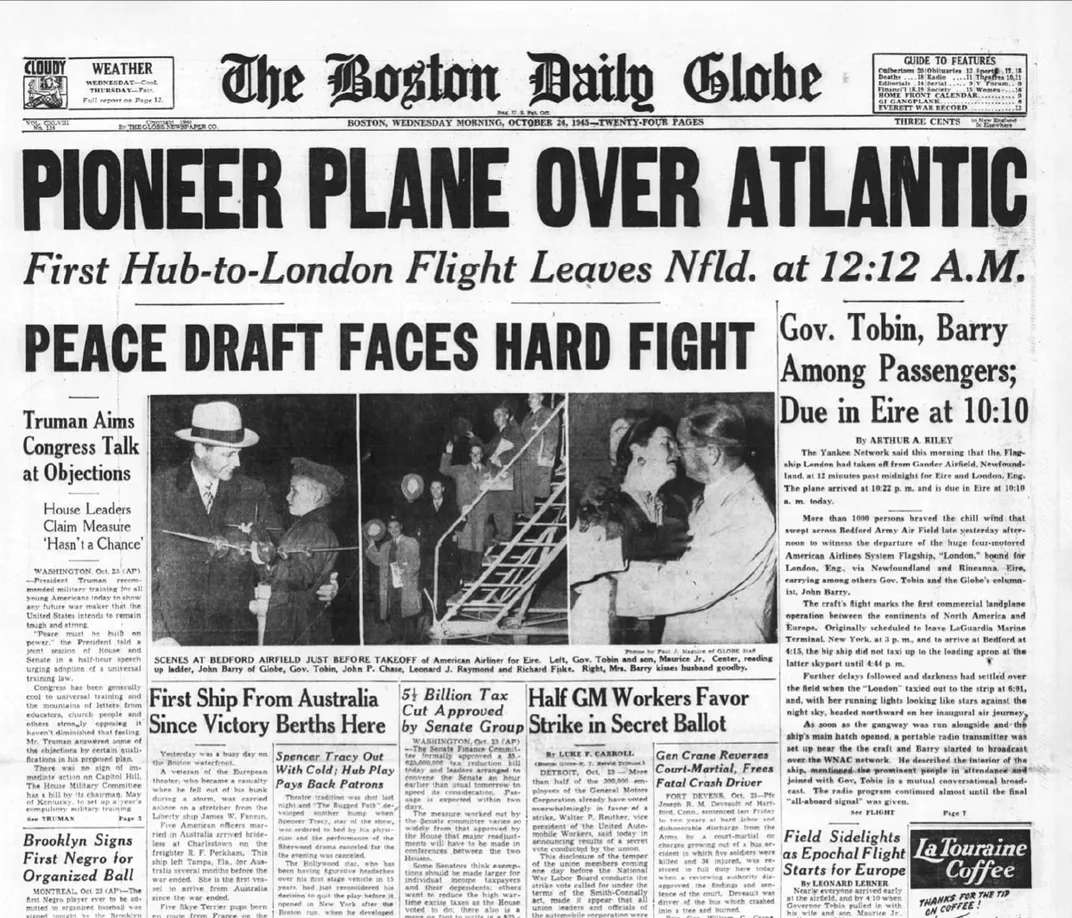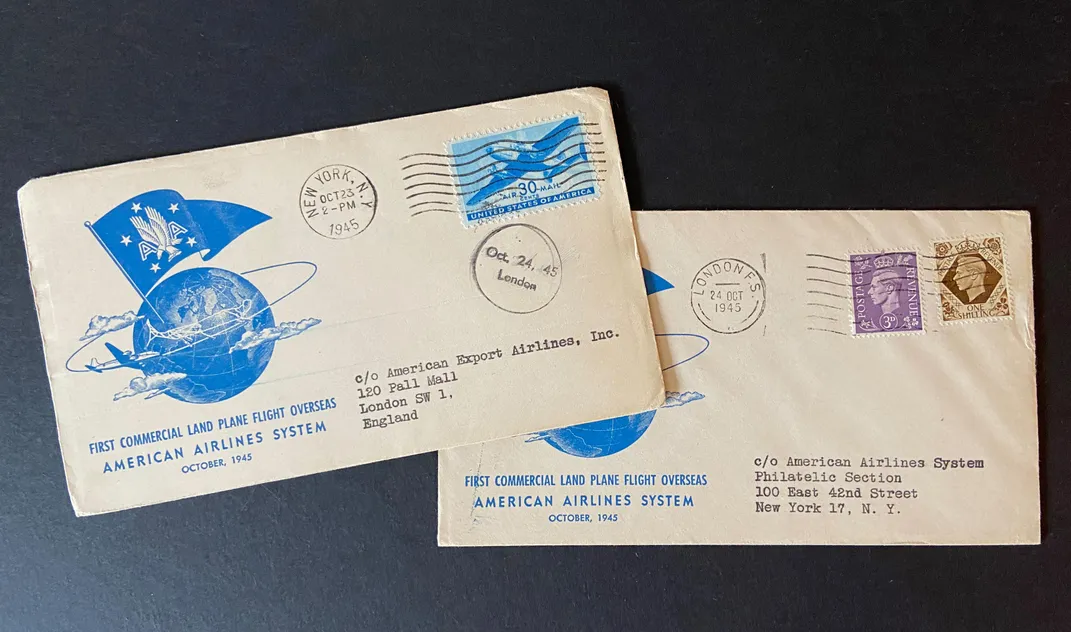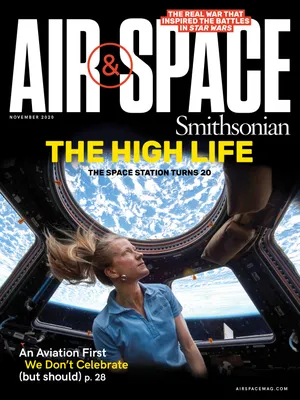The Dawn of Transatlantic Flight
Modern passenger service across the ocean began on October 23, 1945, a date that will live in obscurity.
:focal(3809x2767:3810x2768)/https://tf-cmsv2-smithsonianmag-media.s3.amazonaws.com/filer/47/48/47487269-eed0-488e-b1c7-4957942eea4c/180_firsttansatlantic-thumb.jpg)
At first I couldn’t figure out what a Second Assistant Postmaster General was doing on a transatlantic press junket to London in late 1945. The New York Times said his name was Gail E. Sullivan, while the Boston Daily Globe had it as “Gael Sullivan.” Perhaps Sullivan had to shout the spelling of his name to reporters to be heard over the drone of the Douglas DC-4’s big radial engines as the unpressurized airplane cruised eastbound at 8,000 feet over the North Atlantic.
The Second Assistant was one of 12 passengers on a VIP flight filled with wire-service correspondents, a radio reporter, airline top brass, and the governor of Massachusetts, the Honorable Maurice J. Tobin. There was also a crew of seven under Captain Charles C. Spencer, including the stewardess, Miss Dorothy Bohannon. But what was a Second Assistant Postmaster doing in this crowd? Then the penny dropped—stamp collectors.
The Second Assistant Postmaster was flying to London for the day to oversee the postmarking of the thousands of first-flight covers packed into the DC-4’s hold, each envelope declaring that it had been carried on the “First Commercial Land Plane Flight Overseas.” And then it was straight home next day on the return flight, carrying a second set of covers with British stamps. Philatelists were thrilled.
Stamp collectors might have considered October 23, 1945 a day to remember, but 75 years later few recall the first scheduled transatlantic service via “land plane” from New York to London—or at least to Bournemouth, a seaside town 100 miles from the British capital. (London’s Heathrow didn’t open to transatlantic flights until May 1946.) Everyone who has ever flown the Atlantic in economy class should have been invited to a big 75th anniversary party—except there was no party. It wasn’t cancelled because of COVID. It was never planned.
So let us raise a glass to that late Tuesday afternoon long ago when a DC-4 named Flagship London and operated by a newly acquired American Airlines subsidiary, American Export Airlines (AMEX), went “wheels up” from LaGuardia Airport. The first stop was Bedford Army Air Field in Boston to pick up Governor Tobin, along with radio personality and Boston Daily Globe columnist John Barry. Then it was on to refueling stops in Gander, Newfoundland and Shannon in the Republic of Ireland before the final hop to Hurn, the airfield at Bournemouth.
For Barry, it was all too much—or maybe too little. His front-page story began: “HURN AIRFIELD, ENGLAND, Oct. 24—History will never believe it! After completing the first commercial flight of a landplane from North America to Europe late this afternoon, the American Airlines flagship ‘London’ came out of the sky over this field, landed gently, came to a stop and a passenger yawned. It was just as commonplace as that.”
A yawn on arrival is the standard salute of most passengers who cross the ocean in today’s landplanes. Yet that first yawn marked the end of the era of the flying boat, the glamorous “Clippers”—the Boeing 314 and the Sikorsky VS-44—that lofted a tiny number of the rich and important across the seas. That yawn signaled the start of airborne travel for the masses. From this humble beginning of 12 passengers, transatlantic passenger traffic increased dramatically, with 312,000 passengers crossing by air in 1950. Henceforth silvery airliners would lift off from concrete runways, carrying business travelers and tourists first by the thousands and then by the millions.
There are sound reasons why the commemoration of the inaugural flight is so…muted. The year 1945 was a historic one, and the 2020 calendar for 75th anniversaries—VE Day, VJ Day, the U.N. Charter, and the atomic bomb for starters—was already crowded.
More importantly, corporate identity left the event a brand orphan. The airline that might have been throwing the party—American Airlines—sold its Atlantic division to Pan Am in 1950. When Pan Am went bankrupt in 1991, Delta inherited its transatlantic routes (but apparently little obligation to celebrate past glories).


In the end, American’s AMEX division was the first airline ready, on the 23rd. (Pan Am wasn’t ready until the 28th.) Aviation News reported that to promote the new service, AMEX had mounted a publicity stunt, “an aerial press conference held over New York City in the first DC-4 to be certificated for civilian transport use.” Reporters and American Airlines top brass circled Manhattan in the refurbished airplane, which had to be repainted a week later after American rebranded its AMEX division as American Overseas Airlines (AOS).
Along with publicity agents and press junkets, this was also the heyday of shoe-leather reporters with “press” cards tucked in their fedora hatbands who haunted oceanliner docks and air terminals to catch returning and departing celebrities. “It seems as if during the past year, I’ve interviewed every world character except Hitler and Mussolini,” said one veteran of a LaGuardia stakeout, “and I wouldn’t be surprised to see them show up at any time.”
Hitler wasn’t going anywhere by late 1945 but the wire services—United Press, Associated Press, Canadian Press, and North American Newspaper Alliance—sent reporters to cover the first trip to London. Their stories made front-page news from Circleville, Ohio to Jacksonville, North Carolina. The Boston Daily Globe went with a banner headline: “PIONEER PLANE OVER ATLANTIC.”
The Washington Star devoted an entire page of its Sunday edition to the implications of the flight. “A new era in trans-Atlantic air travel began late this month as United States air lines inaugurated a speedy low-priced service,” proclaimed Joseph A. Baird. “It was the first step toward a not-too-distant future when a weekend jaunt to Europe will be hardly more expensive than a trip to the West Coast.”
Low fares and weekend transatlantic jaunts have since proved elusive, but Baird was right. In 1945, the technology and the operating experience were finally in place.
The Globe’s John Barry reported that the converted airliner was roomy: “They took two or three rows of seats out so we can walk around the plane. We could go up on the flight deck. I didn’t bother to go up there until 4 o’clock this morning, when the captain asked me to come up. It was just zero up there. There was ice on the wings. But this didn’t seem to bother them inside. I would recommend anyone taking this transatlantic trip to buy a pair of bunny slippers, because their feet will be cold.
“Along about 9 o’clock, I heard the cry that we were landing,” continued Barry. “Well, I rushed up to the flight deck, and there in the distance I could see the green fields of Ireland.” The Flagship London was refueling at Rineanna, the land-base twin of Foynes, the seaplane base across the Shannon River where the great flying boats had landed throughout the war. Foynes would wither within weeks as Pan Am and American quickly shut down seaplane service to Europe.
“Then we went over the Shannon River, over County Clare, down to the airport where we got a royal greeting,” wrote Barry. “The Governor was greeted by his cousin who came down from his hometown near Cork. And what a man. He is the greatest weightlifter in all Ireland and stands 6 ft. 6 in. He took the Governor away with him.”
Wherever the giant cousin took him, Governor Tobin stayed on in Ireland for a few days. The other passengers, including Barry, went on to London. Barry ended his reporting with: “I want to tell you folks that travel—transatlantic travel—is going to be commonplace, a daily thing.”
/https://tf-cmsv2-smithsonianmag-media.s3.amazonaws.com/filer/ac/2a/ac2ac6a5-de61-4d61-b4b1-944e00541490/13m_on2020_dc-4_photob_live.jpg)
After American Export Airlines vanished into the American Airlines portfolio, international flying blew a hole in the airline’s bottom line. In 1950, American’s unsentimental boss, C.R. Smith, cut a handshake deal in the concourse of New York’s Grand Central Station with Pan Am’s Juan Trippe to hand over at a great loss its AOS transatlantic aircraft, employees, and routes. “The smartest thing we ever did was to get the hell out,” said Smith. American Airlines did not return to London service until 1991, when it bought out the Heathrow gates and assets of a failing TWA.
About the DC-4 that made the historic transatlantic flight, there is a mystery. AMEX called all its big airplanes “flagships.” All the newspaper accounts of the first flight agree that the aircraft was the Flagship London. The reporters didn’t bother with tail numbers. Geza Szurovy’s 2000 book Classic American Airlines credits that first flight to a DC-4 named Flagship New England, with tail number N90904. No Flagship London is mentioned. If the Flagship London was later renamed Flagship New England, then it came to a terrible end. In October 1946 on takeoff from an airfield at Stephenville, Newfoundland, Flagship New England N90904 plowed into a hillside, killing all 39 onboard.
If the first-flight DC-4 wasn’t N90904, then it was sold out of the American Airlines fleet with the other converted DC-4s as pressurized, high-altitude DC-6s and Lockheed Constellations took over the transatlantic service. The ex-American DC-4s were passed down the chain of used aircraft sales, finally disappearing from the Federal Aviation Administration’s tail-number registry.
Then I remembered Second Assistant Postmaster General Sullivan. I consulted eBay and quickly found a matched pair of Sullivan’s first-flight covers with U.S. postage going east and Royal Mail stamps going west. The stamp on the back of the U.S. covers reads: “This is to certify this cover was carried on the first commercial flight from Boston (Bedford Airport), USA, October 23rd, 1945 to London (Hurn Airport), England.” The stamp doesn’t identify the aircraft, but I got both covers for $8 plus shipping and handling. They will be the guests of honor—well, the only guests—at my First-Commercial-Flight-of-a-Landplane-from-North America-to-Europe 75th Anniversary Party. Oh, for a pair of bunny slippers.
